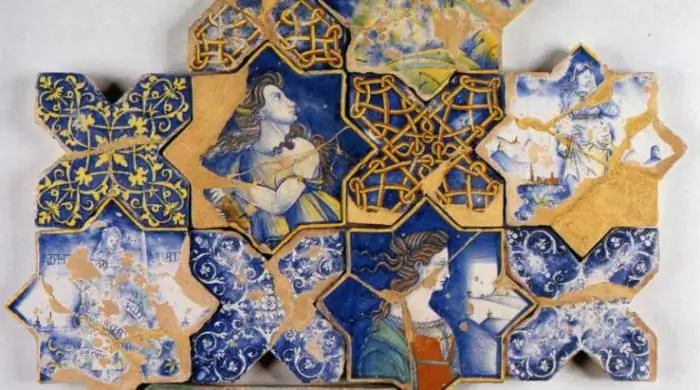2026 Author: Howard Calhoun | [email protected]. Last modified: 2025-01-24 13:10:35
Kilns for firing ceramics are classified according to different criteria and there are quite a lot of them. If you need to buy such a device or make it yourself, you will have to understand these subtleties. It should be noted right away that the easiest way to make will be an air-type muffle furnace.
Kiln type by heater location
The main classification is according to the location of the heating elements. There are only two types. It can be a furnace of a muffle design or a chamber one. If the device is made in the form of the first design, then the heating elements will be located around the chamber of fire-resistant material (muffle). As for the chamber type, in this case the heating element will be located inside the chamber itself.
A distinctive feature of chamber types is that they have less heat loss, since the heat from the element is not consumed to overcome the refractory. However, in some cases, it is simply necessary to use a muffle layer, as it will provide high performance. Chamber furnaces are characterized by the fact thatthere are no obstacles between the ceramic product and the heat source, which means that the heating temperature will be much higher. Most often, such equipment is professional.

Types by loading type
The general classification on this basis divides all units into only two types - frontal and vertical. Detail description is as follows:
- horizontal fixtures are loaded from the front through the camera;
- there are tubular devices, they are also sometimes called circular, they have a vertical loading method, and they are also designed for firing art-type ceramics, this contributes to a more even distribution of heat;
- bell-shaped structures are also loaded from above, but they are designed for larger products.
Another important parameter is the type of filler. Chamber furnaces and muffle furnaces are divided into three types according to this class.
- first class is general purpose and the chamber is filled with air;
- second type filled with vacuum;
- the third type is chambers with a gaseous environment inside, and they differ in that heating also occurs in a special atmosphere created by these gases.

Temperature specifications
Another very important parameter for a ceramic kiln is the temperature. It depends entirely on things like the design of the equipment and its purpose. The hottest furnaces are characterized by temperatures up to 1400-1800 °C. resultwork in such kilns is usually ceramic with a color ranging from white to orange. If the furnace is at a lower temperature, then as a result, clay products can be obtained, the shades of which will be from dark red to burgundy. The most low-power furnaces for firing ceramics are characterized by a temperature of less than 500 ° C. Such devices are capable of producing ceramic products with shades of only red.

Assembly materials
Kiln for firing ceramics can be made with your own hands, if you know a brief instruction, and also have all the necessary materials for assembly. It should also be said that the muffle furnace can be with a gas and electric heater. Gas ones will even be several times cheaper due to the fact that you will have to spend less on fuel, but according to the law, such devices cannot be made by hand. In addition, from a technical point of view, a gas oven is extremely difficult to manufacture.
In order to successfully assemble an air-type muffle furnace with an electric heater with your own hands, you will need:
- angle grinder and one or two wheels;
- welding and electrodes for it;
- locksmith tools;
- another important element is 2mm thick nichrome wire.
From the materials you will need the following list:
- body from an old steel type oven or steel sheets with a thickness of 2.5 mm;
- corners, fittings;
- bas alt wool for thermal insulation;
- chamotte brickrefractory type and brick with the same properties;
- silicone sealant.

Highlights
The instructions for the muffle furnace are quite large, it is difficult to describe the whole process, but it is worth highlighting the main points.
It's best to have an old steel oven casing handy, as it already has everything you need to make an acceptable oven casing. There is all the thermal insulation here, it will only be necessary to get rid of unnecessary plastic elements, if any. Next comes the heating element, which is the key.
From it will be the heating temperature, hence the quality of ceramic products. As such an element, a previously prepared nichrome wire with a minimum thickness of 1.5-2 mm will act. Then follows the process of arranging the thermal insulation of the furnace. To do this, the body must be overlaid with refractory fireclay bricks. From above, it is necessary to additionally overlay the entire structure with bas alt wool.
The price of a ceramic kiln starts at 40,000 rubles and can go up to 700,000 rubles.
Recommended:
Ceramic material: properties, production technology, application

The first pottery appeared long before people learned how to smelt metal. Ancient pots and jugs that archaeologists find to this day are proof of this. It is worth noting that the ceramic material has unique properties that make it simply indispensable in some areas
Ceramic factory in Voronezh: address, history, products

Ceramic plant in Voronezh is an enterprise for the production of tiles and related products. It has existed on the territory of the city for more than 50 years, but still, for many residents of the city, the activity of the plant is shrouded in a veil of secrecy. Today we will tell you where the company is located, what it produces and what stages of its existence it has gone through

